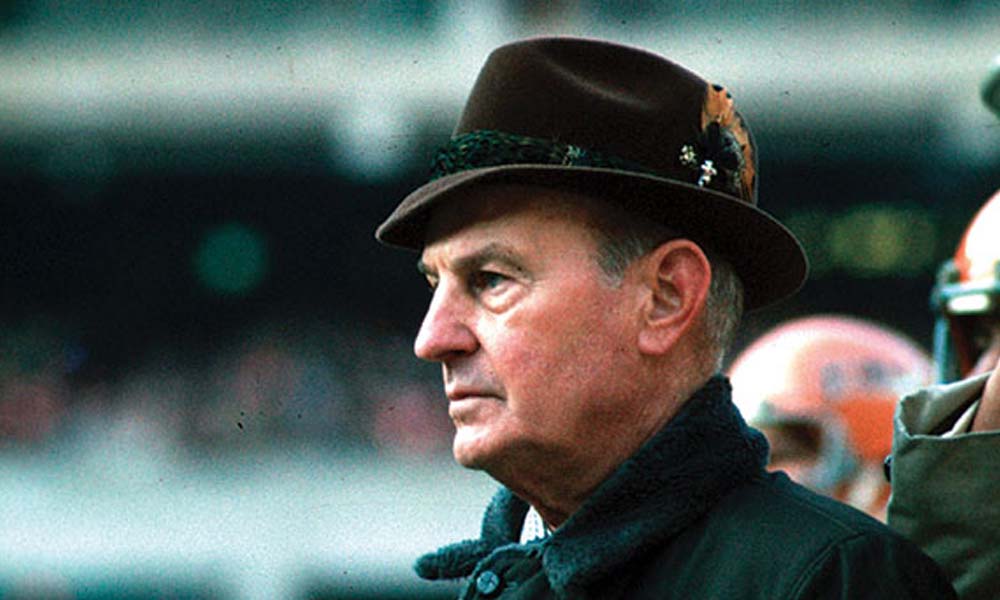Cleveland native and Hollywood actress Patricia Heaton of Everybody Loves Raymond and The Middle once told a joke about pro football coach Paul Brown: “A football player died and went to heaven. He saw a football game in progress and on the sidelines, a man in a tie, coat, and fedora hat watching intently. The football player asked St. Peter, ‘Is that Paul Brown?’ St. Peter responded, ‘No, that’s just God pretending to be Paul Brown.’”
The joke slyly illustrates the enormous impact and legacy Paul Brown had on the game of football. Pre-Brown, it was characterized mostly by brute force, with little intellectual finesse. Brown’s genius for innovation transformed it into the mental and analytical game that it is today.
This year marks the 30th anniversary of Paul Brown’s death, and his innovations continue to touch almost every aspect of the modern-day sport. “Paul Brown was the pioneer of coaching the game of football as a science,” says former Ohio State University head coach Jim Tressell, now president of Youngstown State University. “Data analytics, meticulous practice planning, playbooks, use of film to study performance — Paul Brown made all of those a part of every coach’s repertoire. It was our study of Paul Brown’s 1942 national champions that gave us the blueprint to become the 2002 national champions.”
John Collins, a member of the Professional Football Researchers Association, takes that a step further: “In my opinion, Paul Brown is one of the greatest football coaches that ever lived, if not the greatest.”
Brown was born in Norwalk in 1908, but grew up in Massillon, where high school football is inextricably woven into the fabric of the history and culture.
As the quarterback for Washington High for two years, he led the Tigers to a 15-3 record. He enrolled at Ohio State, but when he didn’t make the team there, he transferred to Miami University in Oxford and went 14-3 in his two seasons as starting quarterback.
Brown became head coach at Washington High in 1932 at the age of just 24 and compiled an astonishing 80-8-2 record (not even including a preseason win in 1940 against Kent State University!). After the Tigers’ third consecutive undefeated season in 1940, Brown was hired at Ohio State in 1941 and led the Buckeyes to their first national championship in 1942.
Then the military called. Brown served and coached in the Navy during World War II, and while enlisted, was hired to coach Cleveland’s new professional team that, as a testament to his popularity (but against his wishes), bore his name: the Cleveland Browns. When he was eventually fired by owner Art Modell, Brown went on to co-found the Cincinnati Bengals in 1967.
Brown began revolutionizing the game while still coaching at Massillon. He invented a radical technique that now is commonplace: the playbook. Players learned formations and set plays and were tested on that knowledge. Brown also developed a method of calling plays from the sidelines using hand signals. A strict disciplinarian with the heart of a teacher, Brown made punctuality and attending classes as important as playing the game. He also emphasized nutrition and made sure his teams ate adequate amounts of wholesome foods by arranging meals through the local YMCA.
In a 2015 interview for the documentary Paul Brown: A Football Life, Bill Belichick, head coach of the New England Patriots, told the NFL Network, “There is no one in the game that I have more respect for than Paul Brown. Everything that he did as a coach, 50 years later, everybody is still basically doing the same thing.”
It’s the most apt tribute that can be given to a man whose vision and genius were far ahead of their time.
Brown’s innovations
Paul Brown deployed almost all of his groundbreaking ideas once he reached the professional level. His accomplishments include:
- First to use game film to analyze opponents’ weaknesses and scout for new talent
- Helped invent the face guard and the radio headset for the football helmet
- First to hire a full-time coaching staff
- Instituted a college scouting system that is still in use today
- First to implement the sideline telephone system to connect to the coaching staff who had a bird’s-eye view of the game
- Developed the 40-yard dash to evaluate the speed and acceleration of players
- Originated the taxi squad and the draw play
- Created the West Coast Defense (also known as the Ohio River Offense)
- Broke the color barrier in professional sports in 1946 by signing on Marion Motley and Bill Willis, a year before Jackie Robinson played for the Brooklyn Dodgers
Paul Brown Museum: 121 Lincoln Way East, Massillon, Ohio 44646 (less than 10 miles from the Pro Football Hall of Fame in Canton). www.paulbrownmuseum.org; 330-833-4061. Tues.– Sat. 9:30 a.m.– 5 p.m., Sun. 2–5 p.m.









